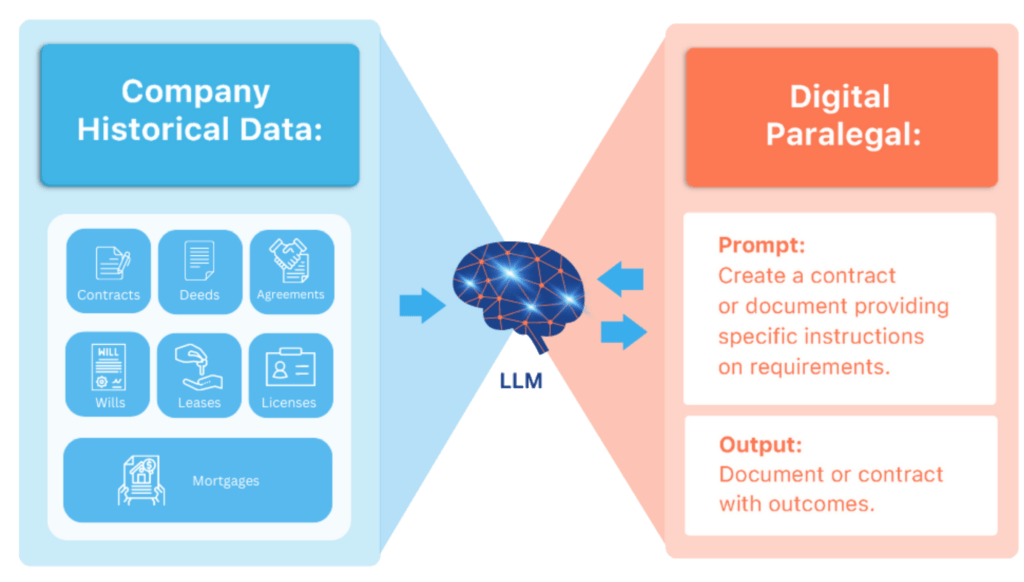Introduction
AI has come to revolutionize how we work, and among the newly developed solutions, the ones that stand out as exceptionally helpful are LLMs, or Large Language Models (such as the one used by Chat GPT or Google Bard). But what exactly are they? And more importantly, how could they be leveraged to obtain competitive advantages in business?
LLMs are extraordinarily powerful computer programs that rely on natural language processing (NLP) techniques and probability calculations to analyze and generate text. They are fed large text data sets from various sources, such as books, web pages, news articles and documents, or conversational text repositories. From there, they learn about language patterns and how words and sentences fit together. Using those learned patterns, they calculate the probability of word sequences to generate the best possible responses.
How could organizations start using these powerful models today? Current business applications encompass extensive fields, from customer service to law or stock trading. Let’s dive into current practices and some examples that V2A is developing for itself and its clients.
In customer service:
LLMs can be used to enhance the customer experience; reviews, questions, mentions or other types of client feedback can be programmatically analyzed by LLMs to identify topics or sentiments and respond with appropriate information or solutions. Some of the most useful applications of LLMs in customer service include:

-
- Chatbots: By powering them with LLMs, they could provide personalized and more accurate responses to customers’ questions and better guidance to solve their issues. While LLM-powered customer support chatbots are not yet commonplace, companies are starting to offer pre-trained copilots for customer support agents. At V2A, we are currently working with a distributor of workplace industrial equipment to design an AI assistant for call center representatives that:
- helps them understand each customer’s profile and characteristics and
- provides them with product recommendations for each customer based on past sales data and similarity with other customers.
- Chatbots: By powering them with LLMs, they could provide personalized and more accurate responses to customers’ questions and better guidance to solve their issues. While LLM-powered customer support chatbots are not yet commonplace, companies are starting to offer pre-trained copilots for customer support agents. At V2A, we are currently working with a distributor of workplace industrial equipment to design an AI assistant for call center representatives that:

- Sentiment Analysis and Topic Extraction: ·By analyzing customer feedback (reviews, social media posts, letters, etc.) with LLMs, pain points and areas of opportunity can be automatically identified as well as the different sentiments associated with certain events, which can be used to make timely adjustments to processes and services.
In editing and document preparation:
It is well known that LLMs can generate content in seconds, but their applications can be further personalized. By feeding personal docu![]() ments or data into a model, it can be used to generate custom documents with a high level of specificity. For example, a law firm could get custom-made contracts just by detailing the most important requirements of the document to the model, which would locate and integrate the right clauses to craft the desired document.
ments or data into a model, it can be used to generate custom documents with a high level of specificity. For example, a law firm could get custom-made contracts just by detailing the most important requirements of the document to the model, which would locate and integrate the right clauses to craft the desired document.
In V2A, we have incorporated this technology into our document preparation protocols. Using our AI proposals editor, we can make instant first drafts of new engagement proposals just by listing the main components of the desired proposal.

In staffing:
LLMs could help streamline recruitment processes by analyzing profiles, resumes, and job descriptions to match candidates with specific positions and even predict success for different candidates. Better and more compelling job postings are another way LLMs could facilitate recruitment tasks.
LLMs can also help design specialized teams for particular tasks or projects by analyzing and matching skillsets and details as specific as career aspirations.
In marketing:
Large Language Models can be used to generate engaging content and accelerate marketing campaigns. From social media posts to articles, LLMs can help ideate content for creative projects, perform proof reading and make recommendations to improve the reading experience. An LLM aided the creation of this insight to structure it more compellingly.
Another use case of LLMs in marketing is market research. Large Language Models can be used to perform extensive research on competition surrounding specific products or services and to track the evolution of trends. At V2A, we leverage LLMs to process the market research data we obtain from surveys, interviews, and focus groups. We develop chat assistants to query/prompt the research data to understand the customer’s pain points and their sentiments and group their feedback into relevant topics (e.g., complaints related to invoicing, product installation, customer service, product delivery, …).
Other applications:
It is important to acknowledge that the applications of LLMs have just begun to unveil their potential and their capabilities may extend beyond our current understanding. Other in development applications we should be mindful of are:

- Trading: LLMs can be used to analyze news, market data and financial indicators to make educated guesses about the upcoming performance of financial assets. As a matter of fact, the financial news company Bloomberg recently launched Bloomberg GPT, a model trained with financial data and news intended to aid in some different tasks involved in financial markets research.
- Security and fraud detection: Using pattern recognition capabilities, LLMs could help flag anomalies in financial schemes and transactions.
Risks and Challenges:
While LLMs hold immense potential, they still present challenges, concerns and risks worth noting. Data privacy is a primary concern, as user data could be distributed without consent. Users also worry that the data they provide to online models will be incorporated and shared with subsequent users. While the latter will not necessarily be the case because models are not constantly being retrained- this data does remain available to model providers to use as they see fit (probably to train a new model).
As for the challenges, LLMs often require intricate adaptations to enhance their performance. Among the most effective and common strategies we can find is fine-tuning the model using smaller, domain-specific datasets or model augmentation with specialized information tailored to the domain.

Conclusion
Large Language Models hold immense potential to revolutionize businesses across various industries. By leveraging the right technical expertise and employing sound methodologies to capture customer needs and objectives, successful implementations of these models can become a reality for your organization.
Leveraging LLMs has its challenges, but it can definitely deliver a competitive advantage to your business. Let us partner with you to explore this game-changing technology.
Disclaimer
Accuracy and Currency of Information: Information throughout this “Insight” is obtained from sources which we believe are reliable, but we do not warrant or guarantee the timeliness or accuracy of this information. While the information is considered to be true and correct at the date of publication, changes in circumstances after the time of publication may impact the accuracy of the information. The information may change without notice and V2A is not in any way liable for the accuracy of any information printed and stored, or in any way interpreted and used by a user.
